A Good Fixed-Blade Survival Knife from a Great Folding Knife Company
2024 Update – Unfortunately, the Little Rive Bowie has been discontinued. We will amend this article if Kizer decided to bring it back, and we will also post an article in our Knife News section if this knife or a similar one is ever released by Kizer.
I think my heart stopped for a moment when I first saw pictures of the Little River Bowie by Kizer in 2018. It’s everything I think a fixed-blade knife should be, right down to the size and blade grind. It looks nice without being too pretty to mess up, it has a solid steel that’s easy to sharpen and G-10 scales that can get wet or dirty without getting damaged.
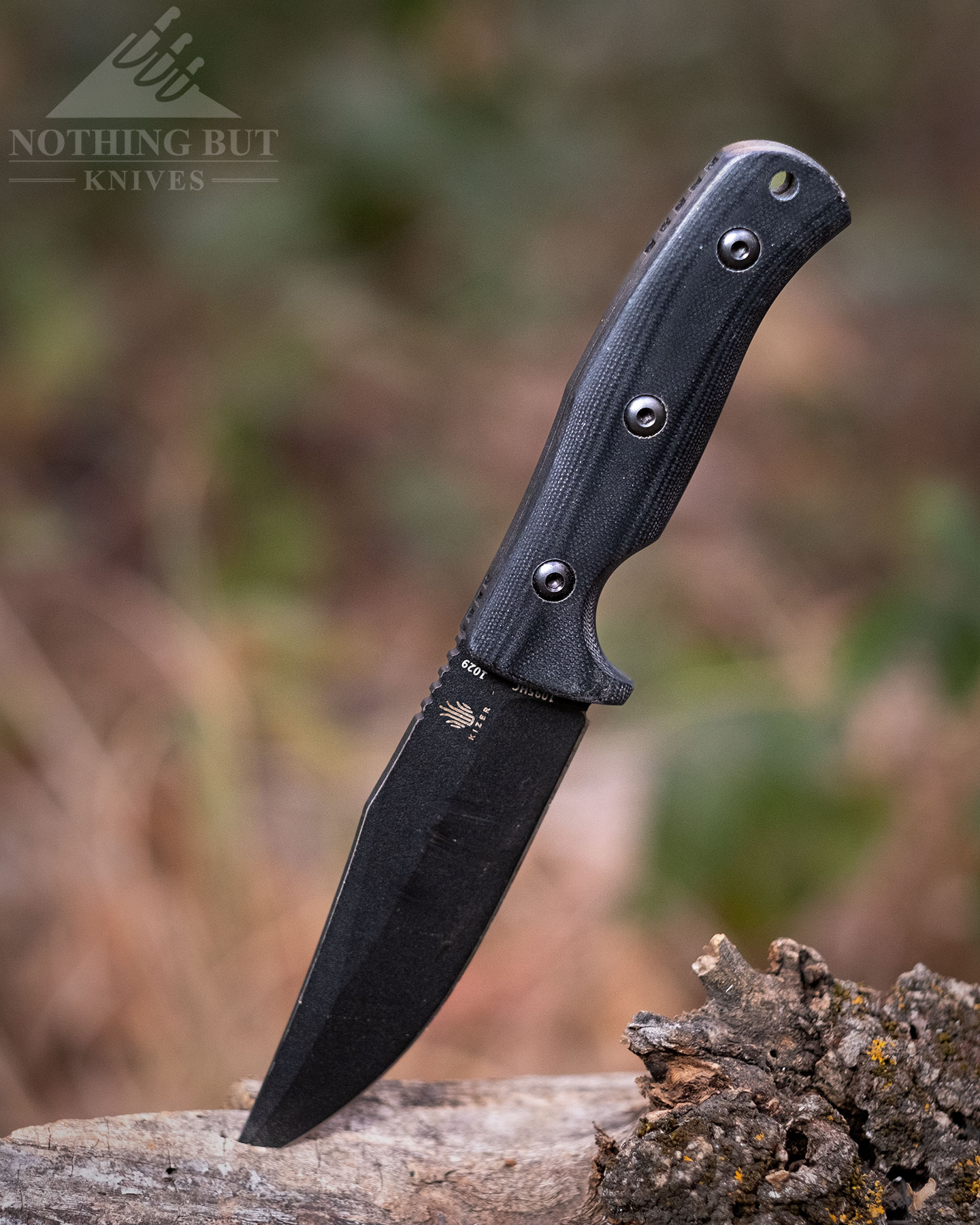
I’m maybe a little biased since I’ve always loved knives like the Buck 119 and wondered why more companies don’t make bowie-style knives around this size.
All these mammoth Bowies out there are cool and all, but I never want to pack them anywhere even when I like the design. Even in the rare case where a giant bowie is well balanced, anything over eight inches is just unwieldy to pack around no matter how good the sheath is. A tiny-framed man like me just isn’t used to that kind of awkwardness.
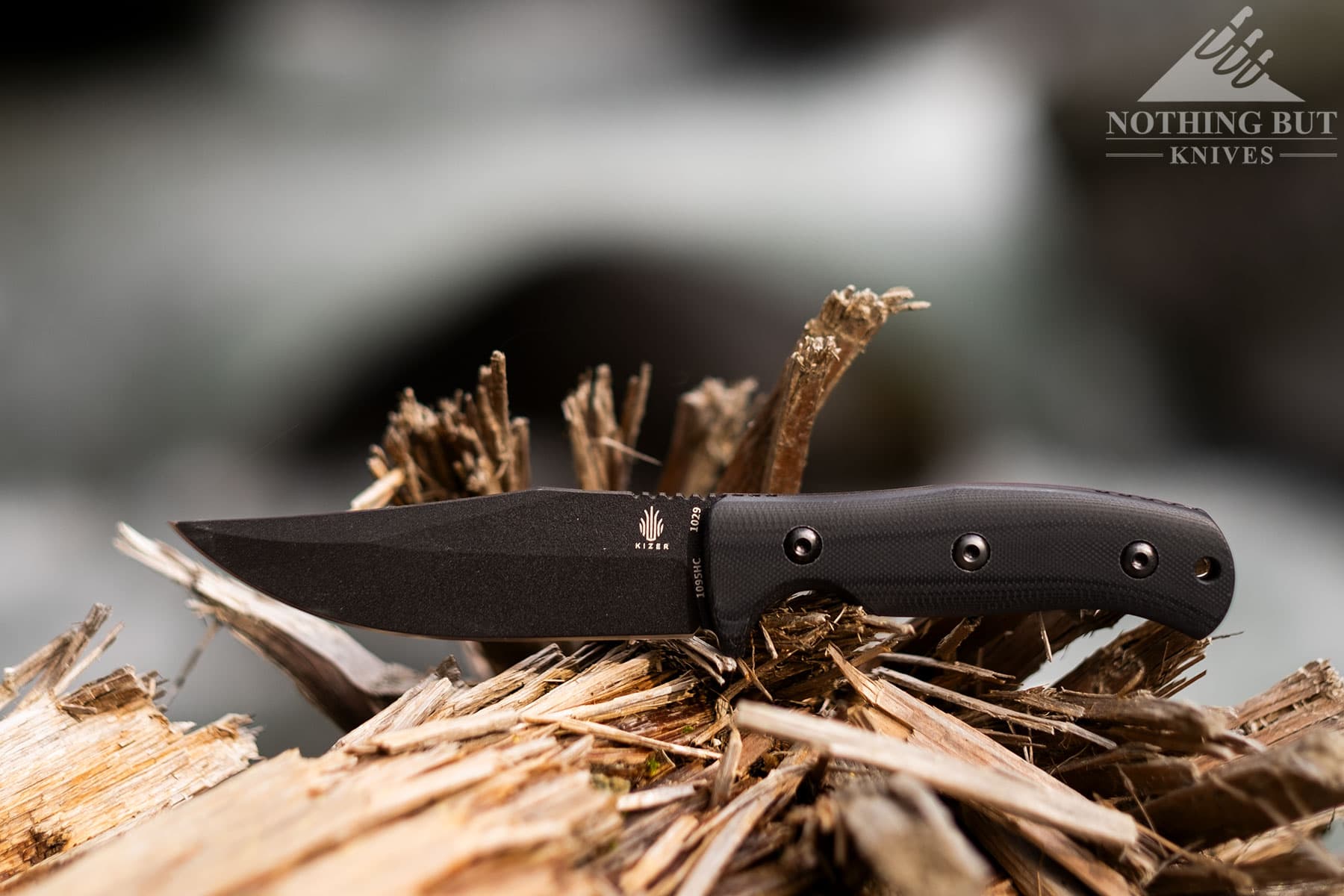
The Little River ended up being most of everything I expected it to be: A well-balanced survival/bushcraft knife that’s fun to use for pretty much anything. There are a few issues with it, mainly in trying to find a decent way to carry it without a lot of modification, and the grip leaves a little to be desired. But as an early attempt at fixed blades by a company that specializes in gentleman and urban EDC, this is a really impressive hunting and survival design.
Late-model disclaimer
After writing most of this review I noticed I was saying a few things different from other people who have reviewed it. I haven’t noticed things like the finish coming off, or the ferro rod not working evenly across the knife. The one we tested has been doing great in both those areas.
I think a lot of YouTube reviews were using an early production model that Kizer was sending out for free. Obviously I don’t know that for a fact, but for now I’m just assuming that the Little River Bowie we bought about a year after it hit shelves is a later production model with some of the wrinkles early reviewers mentioned ironed out.
I tlooks like Kizer has discontinued the Little River Bowie which is unfortunate. If you are looking for a well designed small Bowie you may want to check out the Sencut Waxahachie or the Civivi Sinisys if you think a pocket Bowie may be your thing.
Specifications
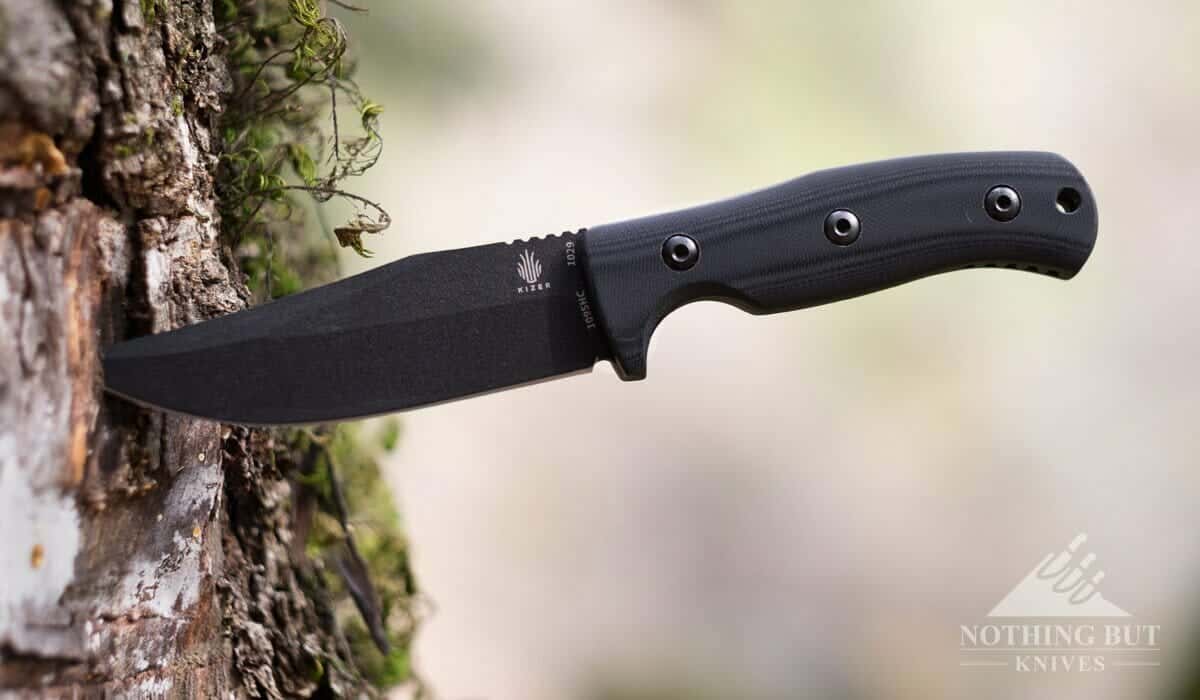
| Overall Length: | 8.75″ |
| Blade Length: | 4.5″ |
| Handle Length: | 4.25″ |
| Handle Material: | G-10 |
| Weight: | 6.21 oz |
| Steel: | 1095 |
| Blade Thickness: | 0.16″ |
| Blade Style: | Bowie |
| Grind: | Flat |
| Sheath: | Kydex |
| Made in: | China |
| Designer: | Dirk Pinkerton |
Pros
| Very sturdy general-use camp knife |
| Comfortable grip |
| Well balanced |
Cons
| Awkward carry in the stock kydex sheath |
| Non-textured handle gets slippery |
The Handle: Good grip, but Needs Texture
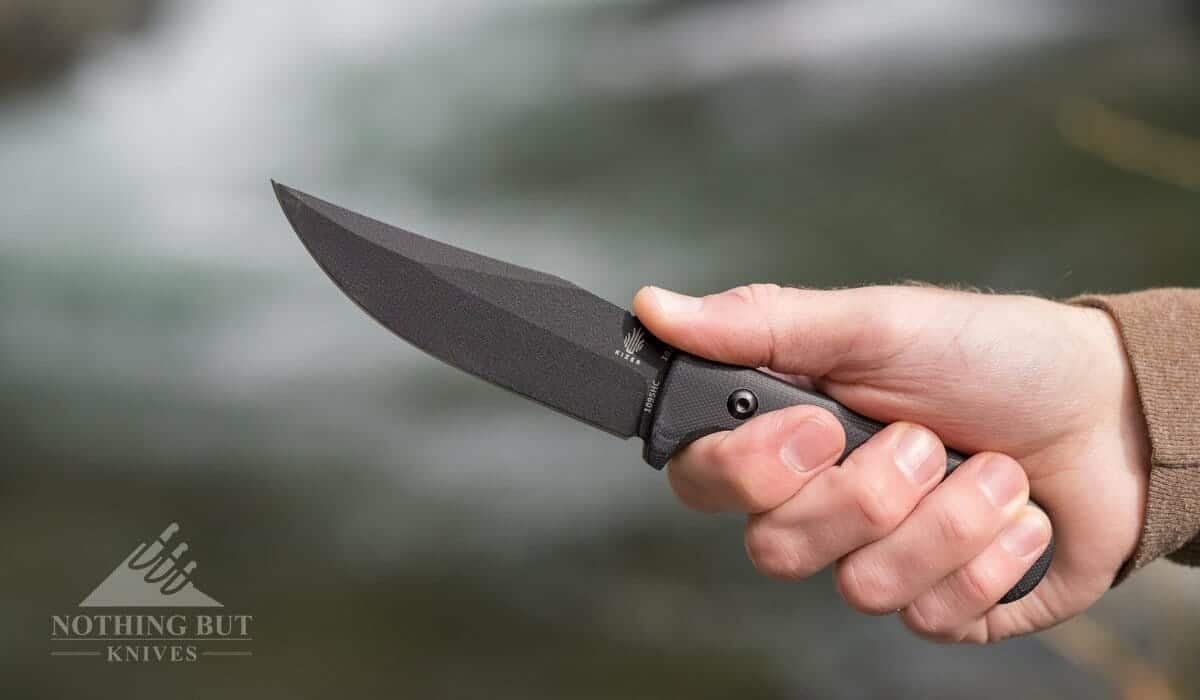
This fits beautifully into the hand. The size and shape is right where it should be for medium-sized hands, but there are a few small things that make it border on sub-par for me.
The biggest issue is how smooth the G-10 scales are. The knife just never feels completely secure. I have yet to be in danger of it slipping out of my hand when I’m actually using it (not just playing with it at my computer), but it definitely feels like a risk when I’m changing grips, and I can feel it slowly working its way out after chopping at a branch for a while.
I haven’t skinned anything with this knife, but I have gotten it dirty and I can tell you the grip does not improve with the addition of mud (cleans up nice, though). I also always feel like I have to grip a little harder to pull it out of the sheath. And the sheath itself definitely doesn’t help in that area, but we’ll get into that later.
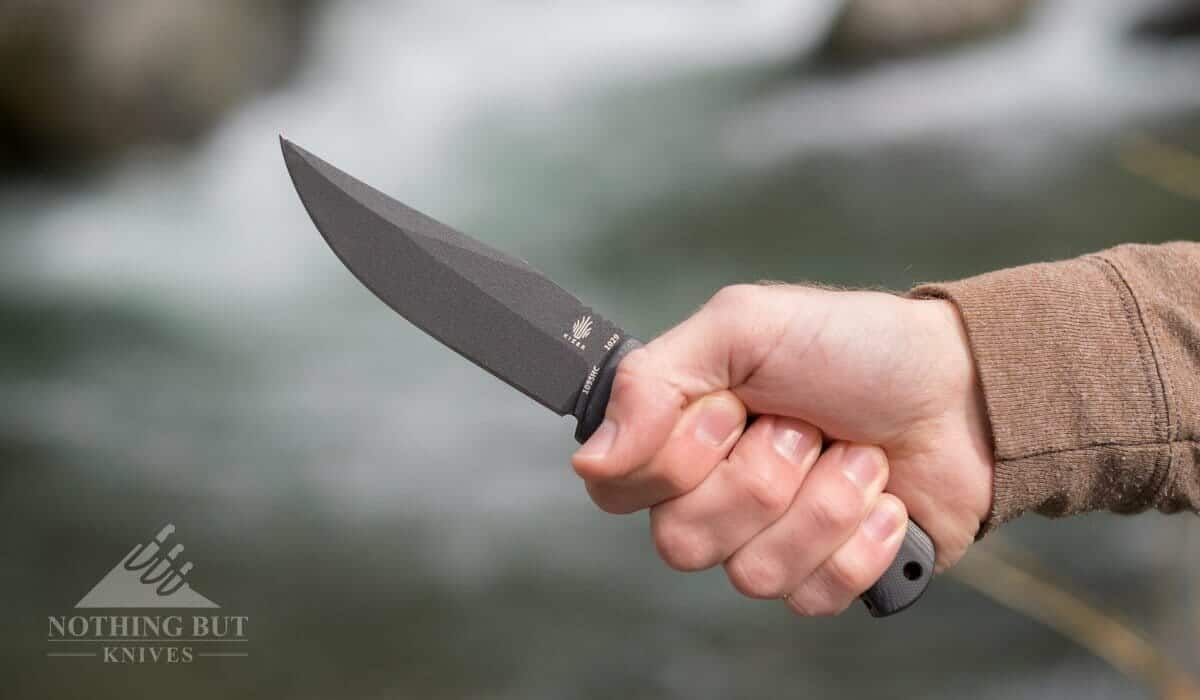
I think they left it smooth for aesthetic purposes, and, to be fair, the handle looks about as nice as G10 can look. It’s just not the most practical feature. It’s actually a credit to the handle’s shape that it hasn’t flown out of my hand yet. Slippery as it can be, I can feel the handle hugging my hand when I swing.
It fits me like a glove, and the balance is just about perfect. But after extended use, it still starts slipping more than it should. It wouldn’t take a lot of texture on the handle to make the ergonomics of the Little River what they should be. It’s a little frustrating that Kizer seems to have opted for aesthetic over function in this little detail.
The Sheath: Great if You Like Getting Punched in the Ribs
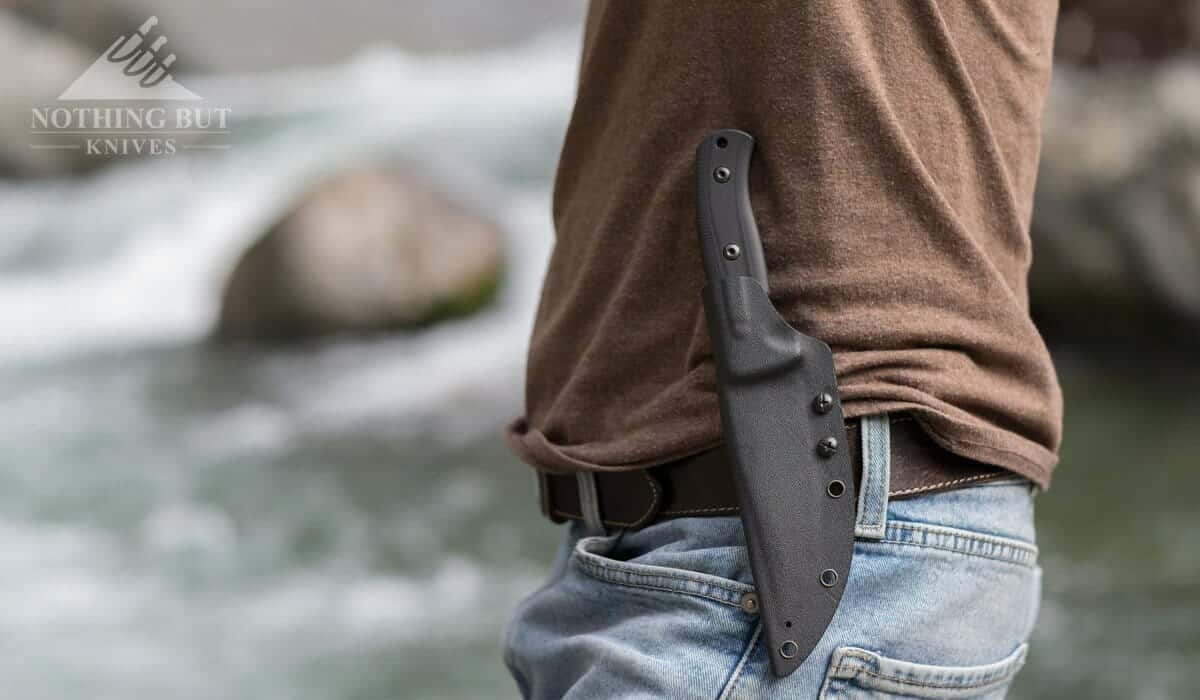
On the good side here, the sheath is light and has great retention. I’ve shaken it pretty hard and couldn’t get the knife to drop out. You could probably wear this upside down and it wouldn’t slip out without some years of wearing out.
Thing is, you almost have to wear it upside down if you’re going to be moving around a lot. There is almost no comfortable way to carry this knife without some modification. A lot of problems stem from the belt loop sitting too low on the sheath. If you carry it vertically, the handle sticks up into your ribs (at least, it does if you’re short like me).
But even a taller person would get an uncomfortable check in their kidney while they’re hiking. You could wear it behind you, but even then you’ll feel the handle riding up your spine, and that’s guaranteed to cause some problems if you climb through any brush or up a tree, and even more problems if you take a fall.
Sloppy Horizontal Carry
The obvious solution to this is horizontal carry, and that’s definitely a possibility since you can unscrew and rotate the belt clip. In fact, that’s one of the main reasons we got the knife in the first place. But again, it causes problems by sitting a few inches to the side of where the knife is balanced. Unless you’re wearing some kind of over-large tactical belt, it just sags toward the handle and makes a fumbling disaster of deploying and sheathing the knife, especially if you’re doing scout carry.
One of your best bets is to go get a Tek-Lok to replace the factory belt clip. That way you can adjust to the belt you’re wearing. You’ll still feel a little bit of that awkward weight distribution from the handle, but it will at elast sit more secure and won’t flop around a lot.
You could also go a completely different direction and run paracord through the holes along the edge of the sheath. Thankfully Kizer made these pretty large, so you could wrap the sheath with just about any kind of rope you’ve got and hold it to your belt or pack that way. But that’s a hell of an adjustment if you don’t normally carry knives that way.
It adds a step to preparation for hiking or camping that I just don’t enjoy as a sporadically lazy person. It’s not that unusual to get a survival knife that needs some additions to become a comfortable carry on the belt or the pack, but this feels a little slap dash on Kizer’s part.
Awkward Deployment
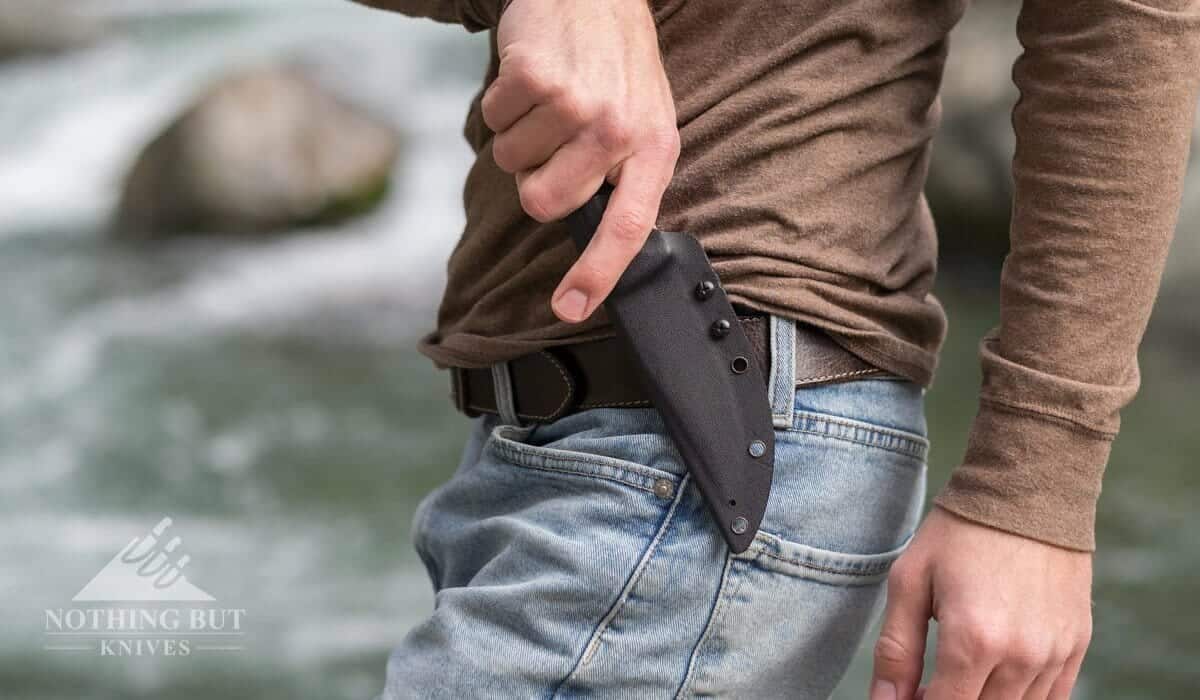
The sheath also makes it a little difficult to deploy the knife. It’s really more of an issue of just adapting to how the knife sits in the sheath. The material rides too far up the handle so you have to grip the butt of the knife to take it out. This isn’t such a big problem once you get the hang of the necessary grip, but it means you either have to readjust the knife in your hand after using your thumb and index finger to pull it out, or learn to deploy it with just your other three fingers.
It’s easy to adjust to, but I can’t see any reason the material needs to ride up the handle as far as it does. Kizer could have cut an inch off that section riding up the handle and really sped up deployment.
It doesn’t feel like they put much thought into the sheath, and maybe Kizer can be given a little leeway for that since this is one of the first fixed-blades they’ve made. Their expertise lies in folders, and the Little River itself is a great knife. I just wish they had hiked around with this thing and workshopped the sheath a little more before they rolled out production on it.
The Blade: Built for Surviving the Wilderness and Me
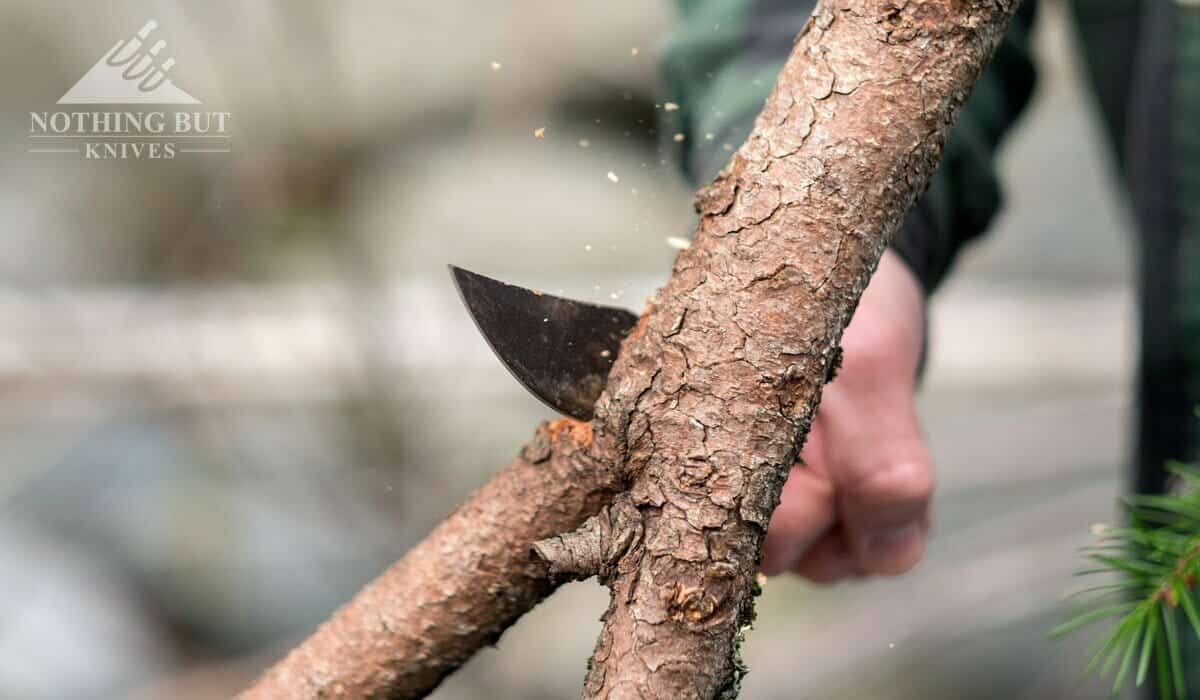
This is where the knife really shines. I love everything about this blade. I like the size, the edge geometry works incredibly well, and I couldn’t ask for a better steel in a general-use survival knife.
This knife gives you a lot of control for bushcraft work. I’m not normally great at making even pieces when I’m batoning, but it was easier to do with the Little River than with any other knife I’ve batoned with. I think the blade geometry has a lot to with that. It doesn’t bite too hard into the wood, so when you’re doing really aggressive work you have plenty of wiggle room to adjust your angles.
It’s pretty nice with a ferrot rod too. I’d heard going into it that the clip point section doesn’t make sparks as well, but I was getting pretty even sparks across the whole spine.
It was a little tricky for me to work with at first, because I’m not that great with a ferrot rod, and the spine only offers so much room to work on above the jimping and along the clip point. Once I got going, though, it was pretty easy to direct the spark where I wanted them to go.
Tough Finish and Steel
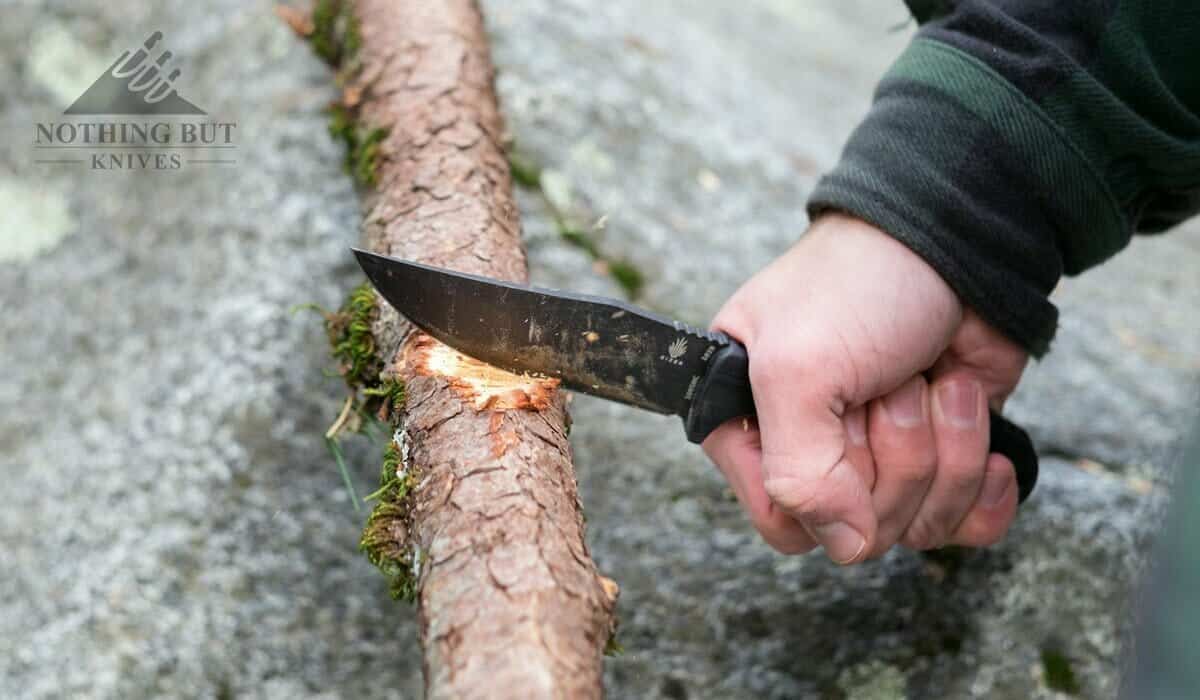
The finish stains very easily. You can see where the wood is marking up the knives in the batoning pictures, and I’ve heard from other people who have used this knife that the finish doesn’t seem to last long. I have yet to chip any of the finish off myself, and it looks like it’s laid on pretty thick, but it’s not going to look pretty for long if you’re actually using this knife for anything besides cutting cardboard.
More importantly, the edge held up really well. Nothing rolled, and there were no chips. I think there was a point I slipped and put the top edge into a rock. There’s a small roughness there, but it’s nothing that can’t be honed out or sharpened with minimal effort.
The base of the edge is so thick, even on the clip point section, that you could probably grind out any catastrophe that falls on this knife and still have a fully functional blade. I’m not too familiar with Kizer’s heat treatment practices, but the way everything is holding up on this knife indicates they know how to cook 1095 steel with the best of them.
The Flat Grind Works for Mostly Everything
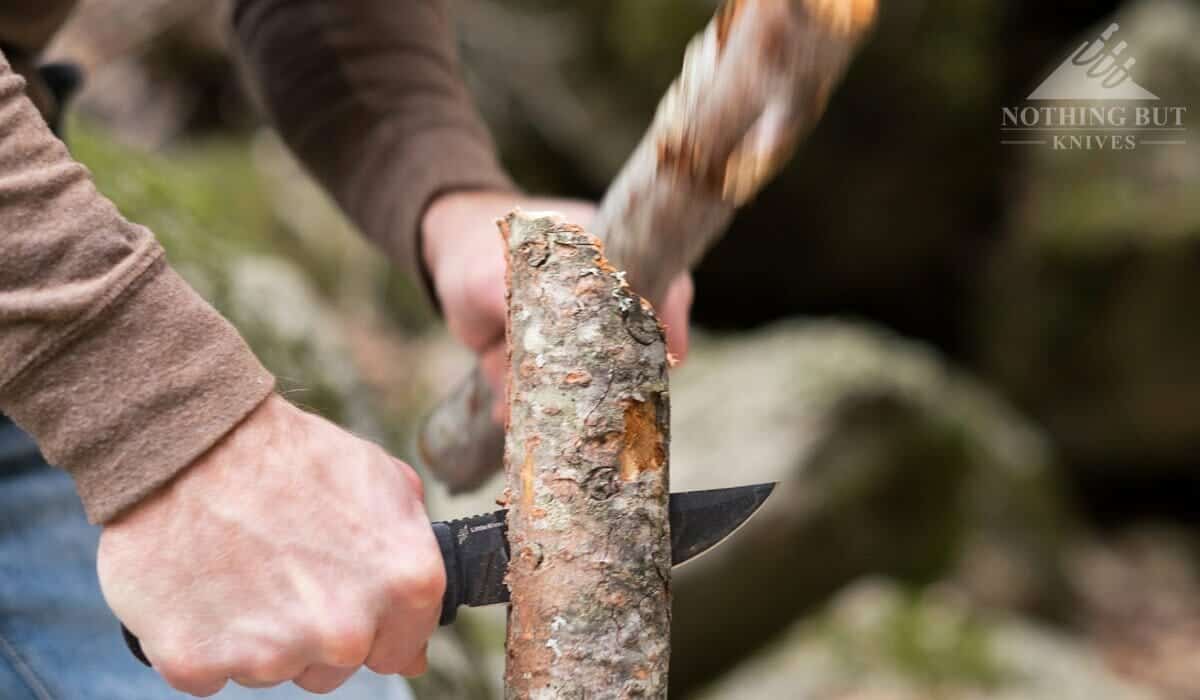
By way of experiment, I went after some branches off an orange tree in my backyard to see how well I could strip the thorns off and turn it into a hot dog stick (which is our go-to survival tactic when out in the bush). It did great stripping the branches. Even though the shortness of the blade got my hand closer to the three-inch thorns than I would have liked, this knife feels so comfortable in the hand that I actually managed to maneuver around the thorns and clean them all off pretty easily without getting poked.
The problem came when I tried to put a point on the stick. It worked, but it took some effort. Whittling is not this knife’s strength. I had to put more muscle than finesses behind shaving than I liked. Granted this was mostly green wood I was working on. It was a little easier on the drier stuff we were testing when we actually took the Little River into the woods. But it still highlights the fact that, if this knife has a weakness, it’s in the finer details.
It can feather just fine, but flat grinds are usually good for that kind of thing anyway, and Kizer did a great job on this flat grind. It’s good for pretty much everything you’re doing out in the woods, but it does hamper its slicing ability somewhat, which makes me think one of the few things it isn’t great for is skinning.
It is absolutely a viable option for skinning game and whittling, but if you’re an avid hunter it’s not the best option you have lying around. I don’t think that was really what Kizer had in mind anyway, and it’s not like there aren’t plenty of hunting knife options in the knife world.
Price Comparison: An Alternative to the Buck 119 or BK2
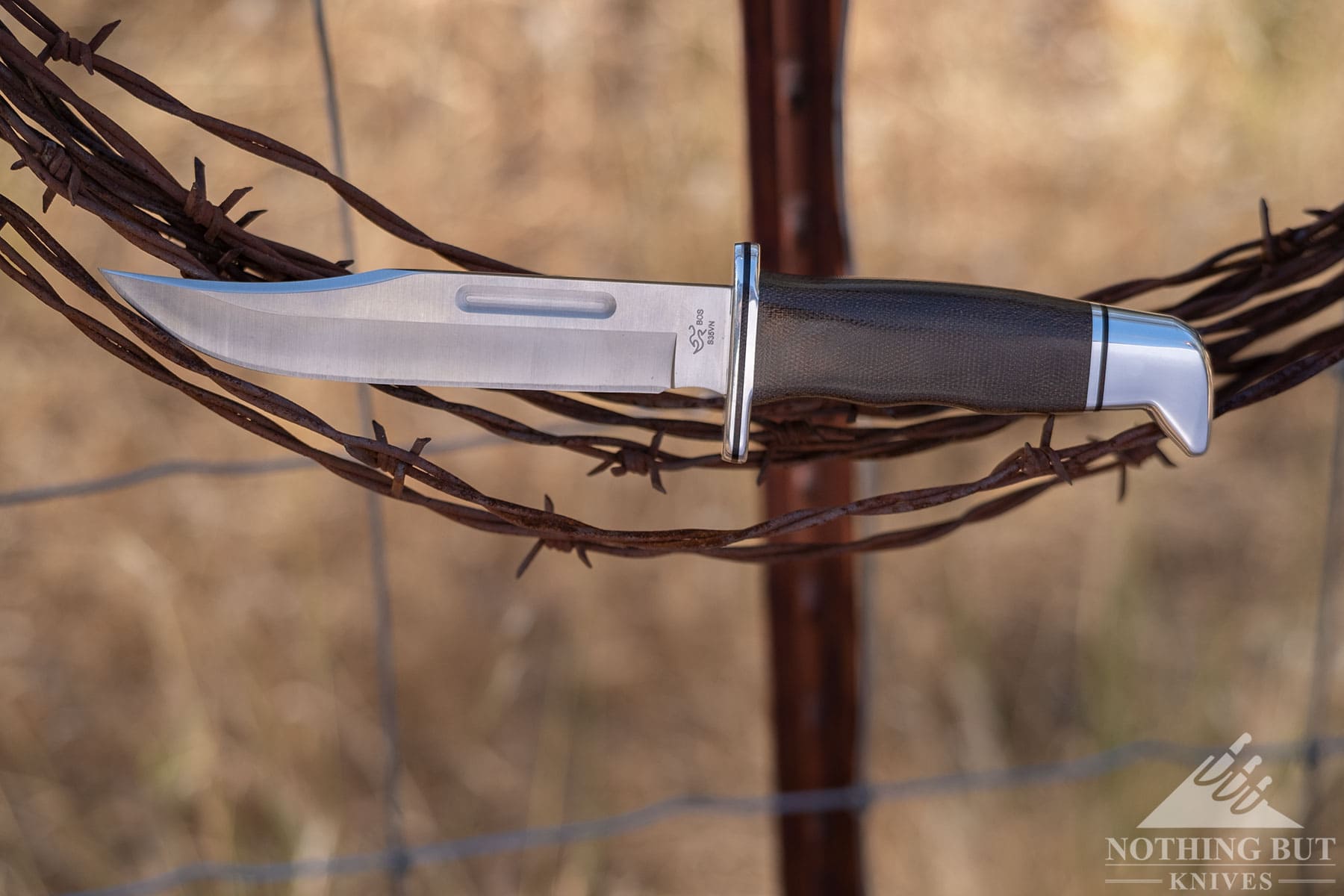
As usual, this is big point in Kizer’s favor. They are really good at pricing knives. At $80 the Little River is in highly competitive territory. That makes it a really tempting alternative to the Buck 119 Special with a wood handle.
The Little River has its problems with grip, but I definitely prefer the grip and overall ergonomics of its G-10 handle to the 119’s slippery phenolic wood handle. The edge grind gives it a bit of a different function from the 119 so it’s not a perfect comparison, but since I’m not a big hunter, I’m not too picky about having a hollow grind, and I do like how much durability the Little River has.
I’m not offering this as a better option to Buck’s 119, but it’s definitely a good alternative if you want something with G-10 scales, a more modern look, and prefer durability over fine slicing.
The knife that presents a problem to the Little River Bowie is the Kabar Becker BK2. Not only is it in the same price range, it serves a similar all-around survival function with a slightly better version of the same kind of steel. It also comes in a MOLLE compatible sheath, which makes Kizer’s low-effort kydex sheath a little embarrassing.
The main thing still running in The Little River’s favor in this comparison is that the balance probably makes it feel a little better in hand thanks to the evenness of its size. There’s a big enough difference between wielding a knife just under 11 inches and a knife just under 9 inches that I would recommend the Little River Bowie as a smaller alternative to the BK2, even if it might be a slightly inferior alternative.
A Really Good Knife with A Few Flaws
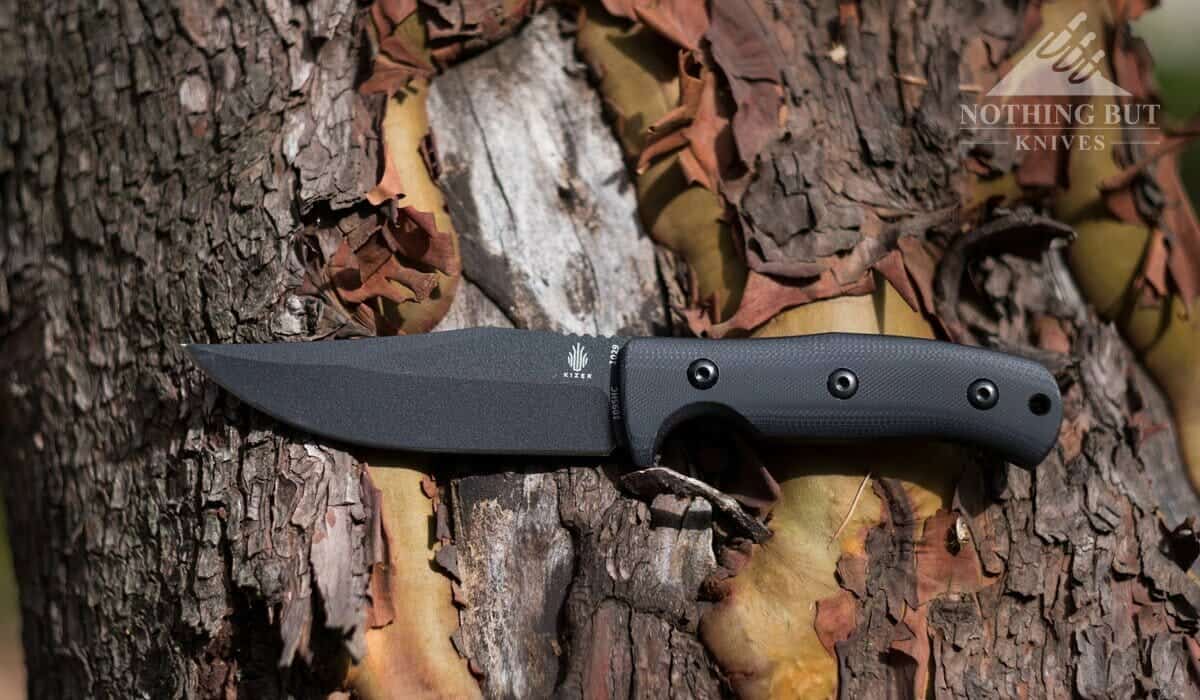
I love this knife. I can’t not love it. It feels fantastic in the hand. It’s fun and functional. I could use it for a million different things in the woods because it’s light and sturdy and well made all around. I want to take it on every camping trip I ever go on.
But I have trouble recommending that people get this knife unless they’re ready to invest in a few small modifications. Namely, converting it to MOLLE carry, and maybe grooving the handle a little so the grip doesn’t get so slippery. There are so many options out there for third party knife sheaths these days that maybe it’s not as big of a deal as I’m making it out to be, but it’s frustrating that such a great knife is such a pain to carry around.
If you can clear that hurdle, though, the Little River Bowie a great survival knife with very few shortcomings.

Do you have one on sale or do you know where I can buy one today? Thank you
Afraid not. Kizer discontinued the Little River a year or two ago, and I hardly ever see it show up in the after market. Check out the Ka Bar BK18 or BK2 for something similar, though.